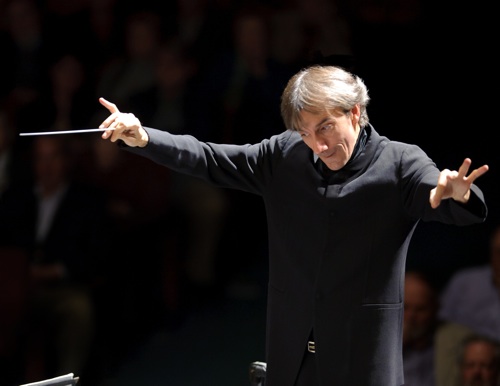Big sound, strong performers at Sonoma State
After a concert at Sonoma State’s Weill Hall one is left with an appreciation for acoustics that should be part of every concert experience. The design and dimensions of this hall, which opened just four years ago, create a sound with a natural loft, clarity and intimacy that is breath taking.
 On Saturday, Oct. 10, Bruno Ferrandis led the Santa Rosa Symphony in a savvy season opener, mixing a populist new work and the timelessness of Mozart, colorist French creations and a brilliant sister act.
On Saturday, Oct. 10, Bruno Ferrandis led the Santa Rosa Symphony in a savvy season opener, mixing a populist new work and the timelessness of Mozart, colorist French creations and a brilliant sister act.
Along with the sound, what most stood out was the high level of professionalism from a cadre of musicians whose names grace the rosters of many local orchestras including the Berkeley and Oakland Symphonies, our “Freeway Philharmonic” hard at work. Under Ferrandis’ florid direction their solos were punchy and their ensembles were full and taut.
They began with the World Premiere of Pax Universalis by Mohammed Fairouz, a surprisingly pop-sounding offering that repeats the same melody throughout. Propelled by dotted-note urgency, Fairouz insinuates strands of Big Western themes and pop Arabic noodling into the work. While he is trying to formulate a sense of cultural identity and distinctiveness within a context of musical universality, the whole affair was a little too Disney.
But the audience loved it.
Immediately afterwards we were treated to an incomparable pair of “soloists,” twin sisters Christina and Michelle Naughton, performing Mozart’s Concerto No 1 in E-flat Major for orchestra and two pianos.
Mozart wrote this at the age of 22 for himself and his older sister Nannerl. They had already been a touring child prodigy act for over a decade, and this was the last piece he wrote before leaving home and his overbearing father. This work was golden and glorious and unmistakably Mozart, but it is still a young composer coming out of the Baroque era.
 After Pax Universalis, I was surprised by the level of accessibility Mozart was striving for, again with the lilt of dotted notes, and with a motif that repeats nearly as much as Fairouz’ populist offering. Yes, Mozart was the pop icon of his day! But his “simpler” forms were not only brilliant in the way they transformed and generated themes, but built the foundations of the Classical era.
After Pax Universalis, I was surprised by the level of accessibility Mozart was striving for, again with the lilt of dotted notes, and with a motif that repeats nearly as much as Fairouz’ populist offering. Yes, Mozart was the pop icon of his day! But his “simpler” forms were not only brilliant in the way they transformed and generated themes, but built the foundations of the Classical era.
And it was a pleasure to hear the sheer playfulness between the two pianos, a mark of his love for his sister. Our identical twins certainly had that, along with a mesmerizing unity in this piece that is all about completing each other’s musical sentences.
After the concert I was able to speak with them for a moment. “Is one of you more Mozart and one of you more Nannerl?” I asked.
“No,” Christina answered. “Mozart was very even in the two piano parts. There is only one area where he seems to express… [personalities].” (I suspect that moment was when the warmer mid-tone piano made her entrance, certainly feeling like an older sister.)
I mentioned that I also have an identical twin brother who lives across the country.
“Oh, do you call him every day?” Michelle asked breathlessly.
“No,” I admitted, and felt guilty. We talked about Poulenc until the pressure of other people ended our conversation, but I later wrote my brother.
And that Poulenc! In his Concerto for Two Pianos those sweet young things showed their ferocious stature in a performance that simply blistered the air. Poulenc, a member of Le Six, was the “bad boy” of French composers, tangling common tunes and naughty jokes into his serious themes. And that irreverence only added to the immediacy of his writing. It was interesting to hear what Ferrandis, a French conductor, would do with this. His gestures were never minimal, like some conductors who strive for understatement in order to focus their squadrons. Ferrandis used his long and expressive hands to inspire a French passion and sensitivity, and his apparent reverence for this icon of the piano repertoire and for these two performers only enhanced their moments of humor.
The twins were firecrackers in the explosive first movement, and then severely internal in the Larghetto, quietly rendering a beauty that was almost intolerable in its constraint. The orchestra crept in on wheezes and sighs and then swelled into romanticism. The Naughtons turned the runs of the Allegro molto absolutely molten with doubled notes and tripping runs, and the orchestra feverishly followed and at times pasted together musical quotations in a fascinating display of artistic assemblage.
And then followed another big work of the French repertoire, Saint-Saëns famous “Organ” symphony. Colorful, woodsy, and driven, this paralleled Schubert’s Unfinished Symphony in its deep architecture and impulses. They both built their tensions out of short violin motifs and then brought out the winds. Where Schubert went for clarinet, Saint-Saëns chose English horn and throaty flutes, and then reprised those short themes into a huge closing argument for piano and organ. That ending is one of the great moments of the literature.
Saint-Saëns was more of a classicist than an impressionist, and actually loathed Debussy’s watery chords and whole tones. But his orchestration expanded on classical choices with very French colors, sumptuous winds and earthy bassoon. The Santa Rosa Symphony brass were crisp and stentorian, well deserving the standing ovation for their magnificent closing.
Next month, Nov. 7 – 9, this excellent orchestra performs Kurtág, Schuman and Brahms with another great pianist, Pedja Muzijevic. More information and tickets available at santarosasymphony.com.
—Adam Broner
Photo top of Bruno Ferrandis, photo by Susan and Neil Silverman. Below, of Christina and Michelle Naughton, by permission.
